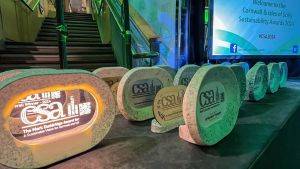Wemyss and March
Introduction
This project is focused on the restoration of 185 hectares of eroding peatland at two sites across the Wemyss and March estate in the Scottish Borders.
Description
The northern site, Talla Moss, borders another close by peatland restoration project 'Talla, Gameshope and Carrifran'. Talla Moss is 11 hectares in size, with 9.7 ha identified as drained haggs and gullies, and a further 0.46 ha of actively eroding areas. The southern site, Winterhope and Chapelhope comprises of a much larger area of degraded peatland with the extent of 156 ha drained, and 6.21 ha actively eroding. Weaving through the Winterhope & Chapeldown landholdings is Happertutie Burn Falls, a designated SSSI/SAC which feeds the River Tweed. This area is of special importance to the river lamprey, brook lamprey, otter, Atlantic salmon and floating vegetation (water-crowfoot). A small section in the south west also falls under the Moffat Hills SSSI. Tweed Forum outlined this area as having restoration potential in delivering catchment wide benefit.
Project Aims
The key objective of this project is to restore these two areas of degraded peatland to a fully functioning state, both of which are currently actively eroding. The majority of the work will involve re-profiling and re-vegetating many kilometres of peat haggs (30,848 metres at Winterhope & Chapelhope; 2,276 metres at Talla Moss). The purpose of the re-profiling and re-vegetating is two-fold. Firstly, it stops the hagging process in its tracks, creating a stable sloping bank and limiting further erosion of the peat. Peat erosion exposes bare peat to the atmosphere, allowing CO2 to be released as the exposed peat oxidises. It potentially also leaches carbon into watercourses and can discolour the watercourses that drain the peatland. In addition, peat haggs (and the gullies that form in between them) lead to greater drainage of the peatland, potentially lowering the water table of the blanket bog habitat, to the detriment of the many specialist plants and animals that rely on it’s waterlogged condition.
Restoration Delivered
The restoration of this project was finalised in 2022 and is awaiting final validation with the Peatland Code.
Site Activity
The activities to achieve the restoration will be carried out by the two successful contractors for this project, both of whom are experienced at re-profiling and re-vegetating peat haggs. Their activities will transform haggs into stable sloped banks that are wholly re-turfed with an intact root zone. To do this they will initially roll back existing vegetation on top of the hagg, so that the underlying peat can be reshaped. The newly created slope is then covered with turf material and tamped down to maximise edge to edge contact and ensure sufficient embedding.
All donor pits will be re-turfed by pulling-in the surrounding turf to infill, and will be no larger than a square metre. The donor pits will themselves become new bog pools, a micro-environment for sphagnum growth, which may also act as points of recharge to the water table.
Restoration activities will be carried out in late-summer and autumn, to avoid ground-nesting birds’ breeding seasons and the challenging weather conditions of the winter months.
{"zoom":12,"lat":55.4824648,"lon":-3.2486788,"markers":{"0":{"lat":55.47111966,"lon":-3.329903225}}}
Project Name: Wemyss and March
Organisation / Lead partner: Forest Carbon Ltd
Location: Moffat, Scottish Borders and Dumfries & Galloway, Scotland.
Approximate area covered: 185 ha
Conservation Status: Site of Special Scientific Interest (SSSI), Special Area of Conservation (SAC)
Predominately: Upland
Peat Habitats: Blanket bog
Project Type: Restoration
Year Project Began: 2021
Peatland Code site: Peatland Code site - Under development












